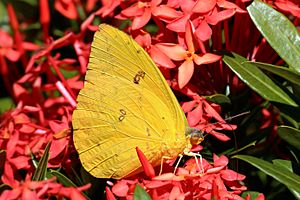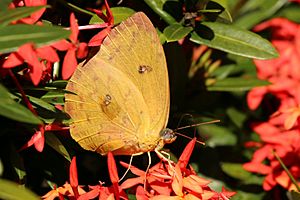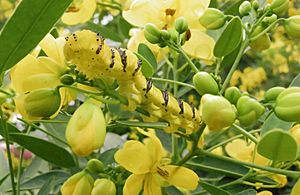Cloudless sulphur facts for kids
Quick facts for kids Cloudless sulphur |
|
|---|---|
 |
|
| Male P. s. sennae, Tobago | |
 |
|
| Female P. s. sennae, Tobago | |
| Conservation status | |
| Scientific classification | |
| Subspecies | |
|
Three, see text |
|
| Synonyms | |
|
Papilio sennae |
The cloudless sulphur (scientific name: Phoebis sennae) is a beautiful, mid-sized butterfly. You might also hear it called the cloudless giant sulphur. It belongs to the Pieridae family of butterflies. These butterflies live in many parts of the New World, which includes North and South America.
There are a few other butterflies that look a bit like the cloudless sulphur. For example, the yellow angled-sulphur has wings with sharper corners. Other types of sulphurs are usually much smaller.
Contents
Where Cloudless Sulphurs Live
Cloudless sulphurs can be found in many places. Their home range stretches from South America all the way up to southern Canada. They are most common in warmer areas. This includes places like Argentina and the southern parts of the United States. You can often see them in Texas, Georgia, and Florida. Sometimes, they fly further north, but they are less common there.
Where They Like to Hang Out
These butterflies love open spaces. You can often spot them in gardens, sunny clearings, and along seashores. They also like areas near rivers and streams.
What Cloudless Sulphurs Eat
Adult cloudless sulphur butterflies drink nectar. They get this sweet liquid from many different flowers. They especially like flowers with long, tube-shaped petals. Some of their favorite flowers include cordia, bougainvillea, and hibiscus. They also enjoy lantana and wild morning glory.
Young cloudless sulphurs, called larvae or caterpillars, eat different plants. They mostly feed on plants from the senna family. They also enjoy munching on partridge peas. One important food source for them in the eastern United States is Senna hebecarpa, also known as American senna.
Life Cycle of a Cloudless Sulphur
The time when cloudless sulphurs lay eggs and grow depends on the weather. In cooler places, they breed from midsummer to fall. In warmer areas, they can breed all year long!
Egg Stage
The life of a cloudless sulphur starts as a tiny egg. It is shaped a bit like a pitcher and is white at first. After a while, the egg changes to a pale orange color. This egg stage usually lasts for about six days.
Caterpillar Stage
When the egg hatches, a small caterpillar comes out. These caterpillars can be yellow or greenish. They have stripes along their sides and black dots in rows on their backs.
Caterpillars eat a lot! They feed on plants like partridge pea and other legumes. They also love plants from the senna family. A full-grown caterpillar is usually about 41 to 45 millimeters long.
Chrysalis Stage
After growing big enough, the caterpillar forms a chrysalis. This is like a protective case where it changes into a butterfly. The chrysalis is pointed at both ends and has a hump in the middle. It can be yellow or green, often with pink or green stripes. Inside the chrysalis, the caterpillar slowly transforms.
Adult Butterfly Stage
Finally, a beautiful adult butterfly emerges from the chrysalis. These butterflies are medium-sized, usually about 55 to 70 millimeters wide. Their wings are long but not sharply angled.
Male cloudless sulphurs are bright yellow on top. Their undersides can be yellow or have reddish-brown spots. Female butterflies can be lemon yellow, golden, or even white. They often have black spots along the edges of their wings. Females also have a black open square or star shape on the bottom of their front wings. The wingspan of an adult cloudless sulphur is typically 63 to 78 millimeters.
-
A cloudless sulphur at the St. Louis Zoo
-
Male P. s. marcellina in Brazil
-
Male P. s. marcellina in Panama
Types of Cloudless Sulphurs (Subspecies)
There are a few different types, or subspecies, of the cloudless sulphur butterfly. They are found in different parts of the world:
- P. s. amphitrite – Found in Chile
- P. s. sennae or P. s. eubule – Found in places like Jamaica, Florida, and Cuba
- P. s. marcellina – Found in Mexico, Brazil, Argentina, and the Galapagos Islands
Images for kids
See also
 In Spanish: Phoebis sennae para niños
In Spanish: Phoebis sennae para niños












